Financial Accounting 1 Assignment: Scenario Analysis and Principles
VerifiedAdded on 2023/01/10
|22
|4487
|97
Homework Assignment
AI Summary
This Financial Accounting 1 assignment solution provides a comprehensive overview of financial accounting principles and practices. It begins with an introduction to financial accounting, defining key terms such as business transactions, and differentiating between cash and credit transactions, as well as internal and external transactions. The assignment delves into the double-entry bookkeeping system, including journal entries, ledger accounts, and the trial balance, with detailed examples. It further clarifies the differences between financial reports and financial statements, outlining the scope, governance, and users of each. The assignment also explores fundamental accounting principles, such as accrual, conservatism, consistency, and cost principles, and applies these to scenarios involving journal entries, ledgers, and trial balances. Furthermore, it includes a discussion of bank reconciliation and control accounts, providing practical applications of these concepts, and concludes with references to relevant sources. This comprehensive solution aims to assist students in understanding and mastering the core concepts of financial accounting.
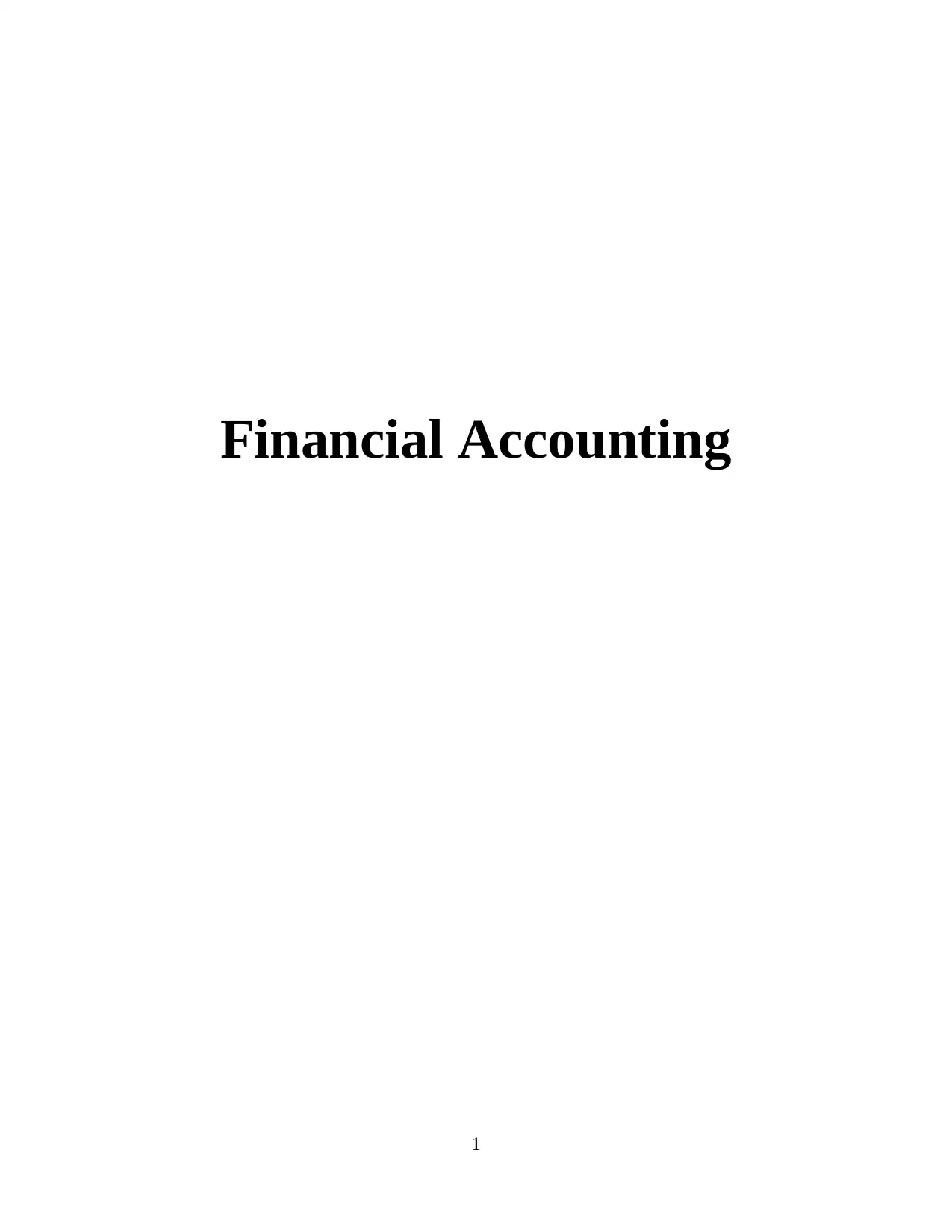
Financial Accounting
1
1
Paraphrase This Document
Need a fresh take? Get an instant paraphrase of this document with our AI Paraphraser
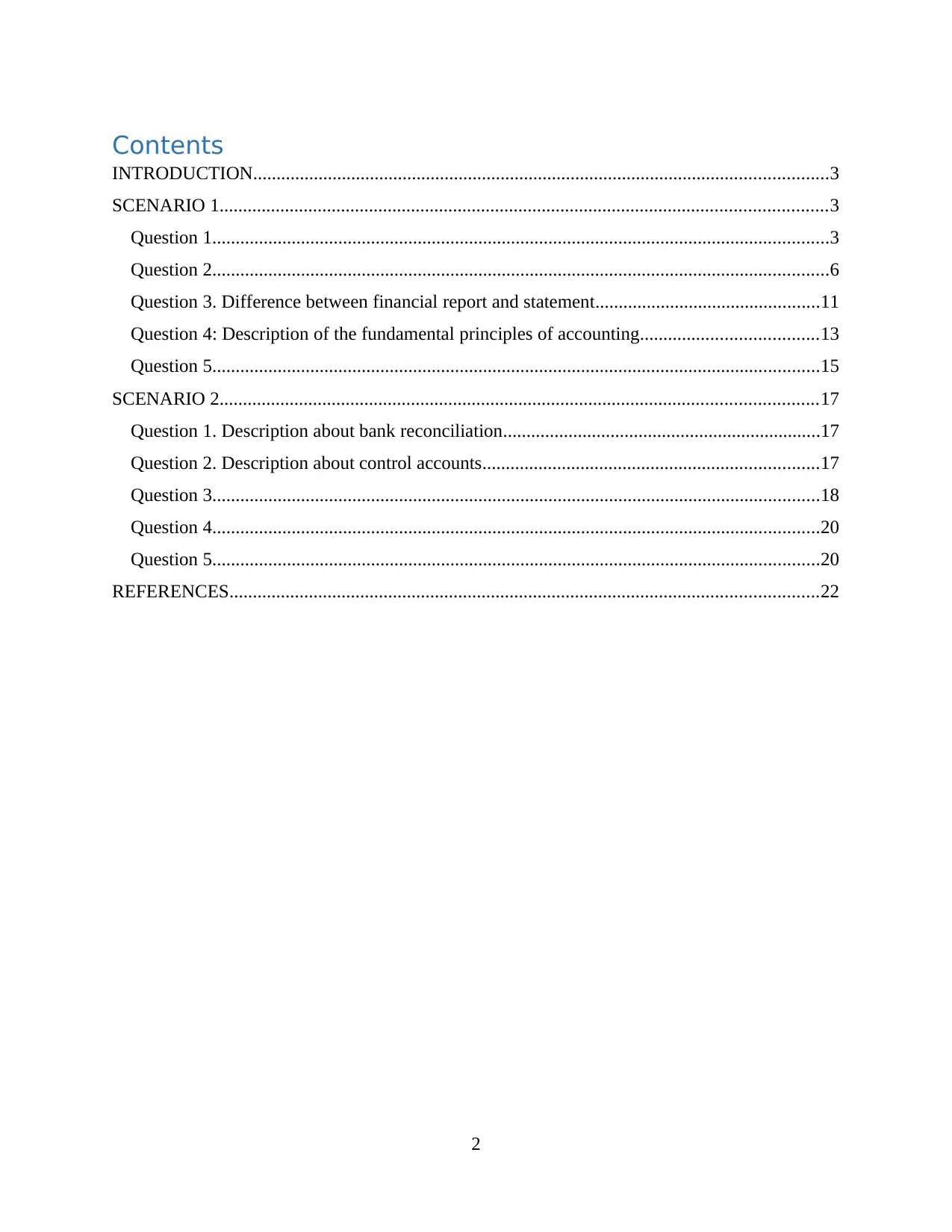
Contents
INTRODUCTION...........................................................................................................................3
SCENARIO 1..................................................................................................................................3
Question 1....................................................................................................................................3
Question 2....................................................................................................................................6
Question 3. Difference between financial report and statement................................................11
Question 4: Description of the fundamental principles of accounting......................................13
Question 5..................................................................................................................................15
SCENARIO 2................................................................................................................................17
Question 1. Description about bank reconciliation....................................................................17
Question 2. Description about control accounts........................................................................17
Question 3..................................................................................................................................18
Question 4..................................................................................................................................20
Question 5..................................................................................................................................20
REFERENCES..............................................................................................................................22
2
INTRODUCTION...........................................................................................................................3
SCENARIO 1..................................................................................................................................3
Question 1....................................................................................................................................3
Question 2....................................................................................................................................6
Question 3. Difference between financial report and statement................................................11
Question 4: Description of the fundamental principles of accounting......................................13
Question 5..................................................................................................................................15
SCENARIO 2................................................................................................................................17
Question 1. Description about bank reconciliation....................................................................17
Question 2. Description about control accounts........................................................................17
Question 3..................................................................................................................................18
Question 4..................................................................................................................................20
Question 5..................................................................................................................................20
REFERENCES..............................................................................................................................22
2
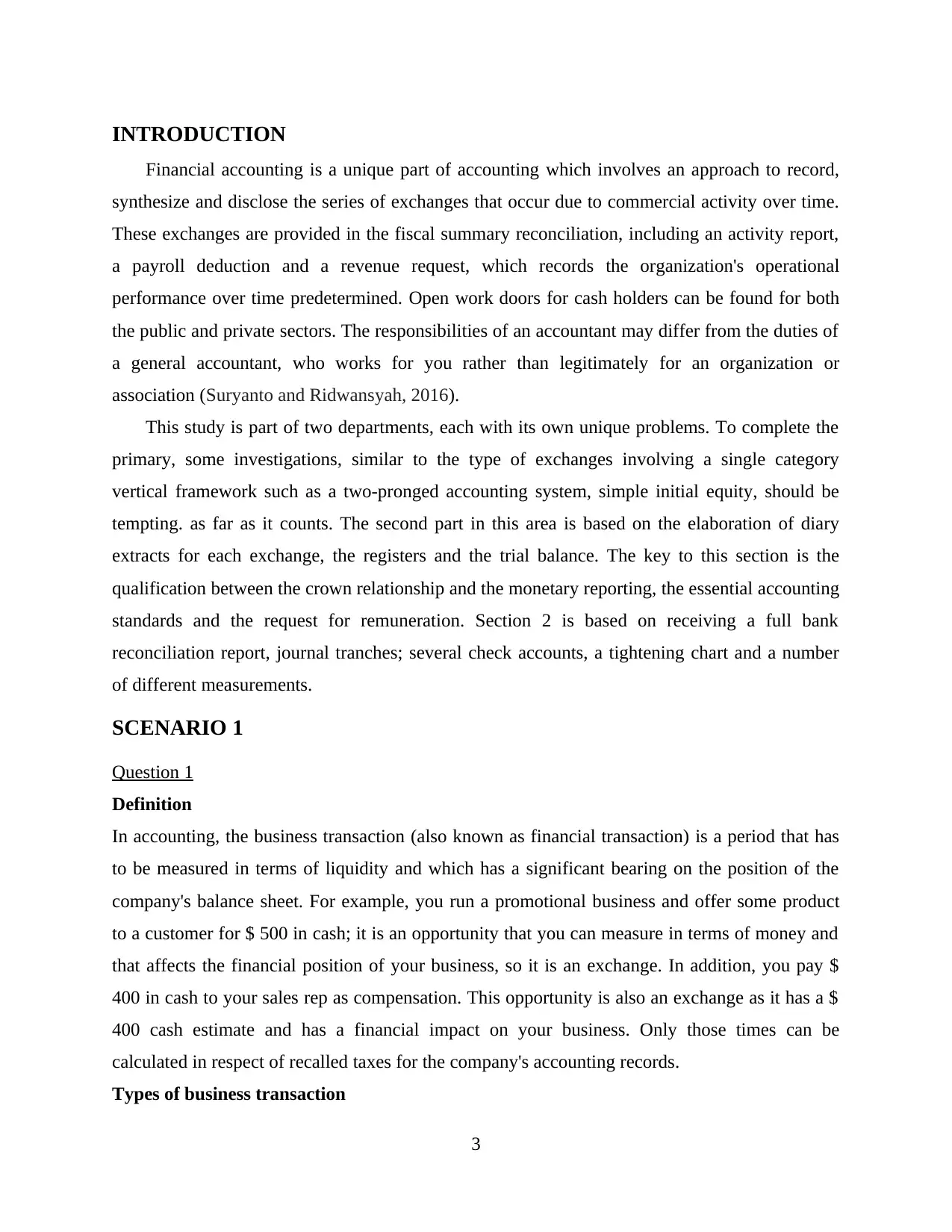
INTRODUCTION
Financial accounting is a unique part of accounting which involves an approach to record,
synthesize and disclose the series of exchanges that occur due to commercial activity over time.
These exchanges are provided in the fiscal summary reconciliation, including an activity report,
a payroll deduction and a revenue request, which records the organization's operational
performance over time predetermined. Open work doors for cash holders can be found for both
the public and private sectors. The responsibilities of an accountant may differ from the duties of
a general accountant, who works for you rather than legitimately for an organization or
association (Suryanto and Ridwansyah, 2016).
This study is part of two departments, each with its own unique problems. To complete the
primary, some investigations, similar to the type of exchanges involving a single category
vertical framework such as a two-pronged accounting system, simple initial equity, should be
tempting. as far as it counts. The second part in this area is based on the elaboration of diary
extracts for each exchange, the registers and the trial balance. The key to this section is the
qualification between the crown relationship and the monetary reporting, the essential accounting
standards and the request for remuneration. Section 2 is based on receiving a full bank
reconciliation report, journal tranches; several check accounts, a tightening chart and a number
of different measurements.
SCENARIO 1
Question 1
Definition
In accounting, the business transaction (also known as financial transaction) is a period that has
to be measured in terms of liquidity and which has a significant bearing on the position of the
company's balance sheet. For example, you run a promotional business and offer some product
to a customer for $ 500 in cash; it is an opportunity that you can measure in terms of money and
that affects the financial position of your business, so it is an exchange. In addition, you pay $
400 in cash to your sales rep as compensation. This opportunity is also an exchange as it has a $
400 cash estimate and has a financial impact on your business. Only those times can be
calculated in respect of recalled taxes for the company's accounting records.
Types of business transaction
3
Financial accounting is a unique part of accounting which involves an approach to record,
synthesize and disclose the series of exchanges that occur due to commercial activity over time.
These exchanges are provided in the fiscal summary reconciliation, including an activity report,
a payroll deduction and a revenue request, which records the organization's operational
performance over time predetermined. Open work doors for cash holders can be found for both
the public and private sectors. The responsibilities of an accountant may differ from the duties of
a general accountant, who works for you rather than legitimately for an organization or
association (Suryanto and Ridwansyah, 2016).
This study is part of two departments, each with its own unique problems. To complete the
primary, some investigations, similar to the type of exchanges involving a single category
vertical framework such as a two-pronged accounting system, simple initial equity, should be
tempting. as far as it counts. The second part in this area is based on the elaboration of diary
extracts for each exchange, the registers and the trial balance. The key to this section is the
qualification between the crown relationship and the monetary reporting, the essential accounting
standards and the request for remuneration. Section 2 is based on receiving a full bank
reconciliation report, journal tranches; several check accounts, a tightening chart and a number
of different measurements.
SCENARIO 1
Question 1
Definition
In accounting, the business transaction (also known as financial transaction) is a period that has
to be measured in terms of liquidity and which has a significant bearing on the position of the
company's balance sheet. For example, you run a promotional business and offer some product
to a customer for $ 500 in cash; it is an opportunity that you can measure in terms of money and
that affects the financial position of your business, so it is an exchange. In addition, you pay $
400 in cash to your sales rep as compensation. This opportunity is also an exchange as it has a $
400 cash estimate and has a financial impact on your business. Only those times can be
calculated in respect of recalled taxes for the company's accounting records.
Types of business transaction
3
⊘ This is a preview!⊘
Do you want full access?
Subscribe today to unlock all pages.

Trusted by 1+ million students worldwide
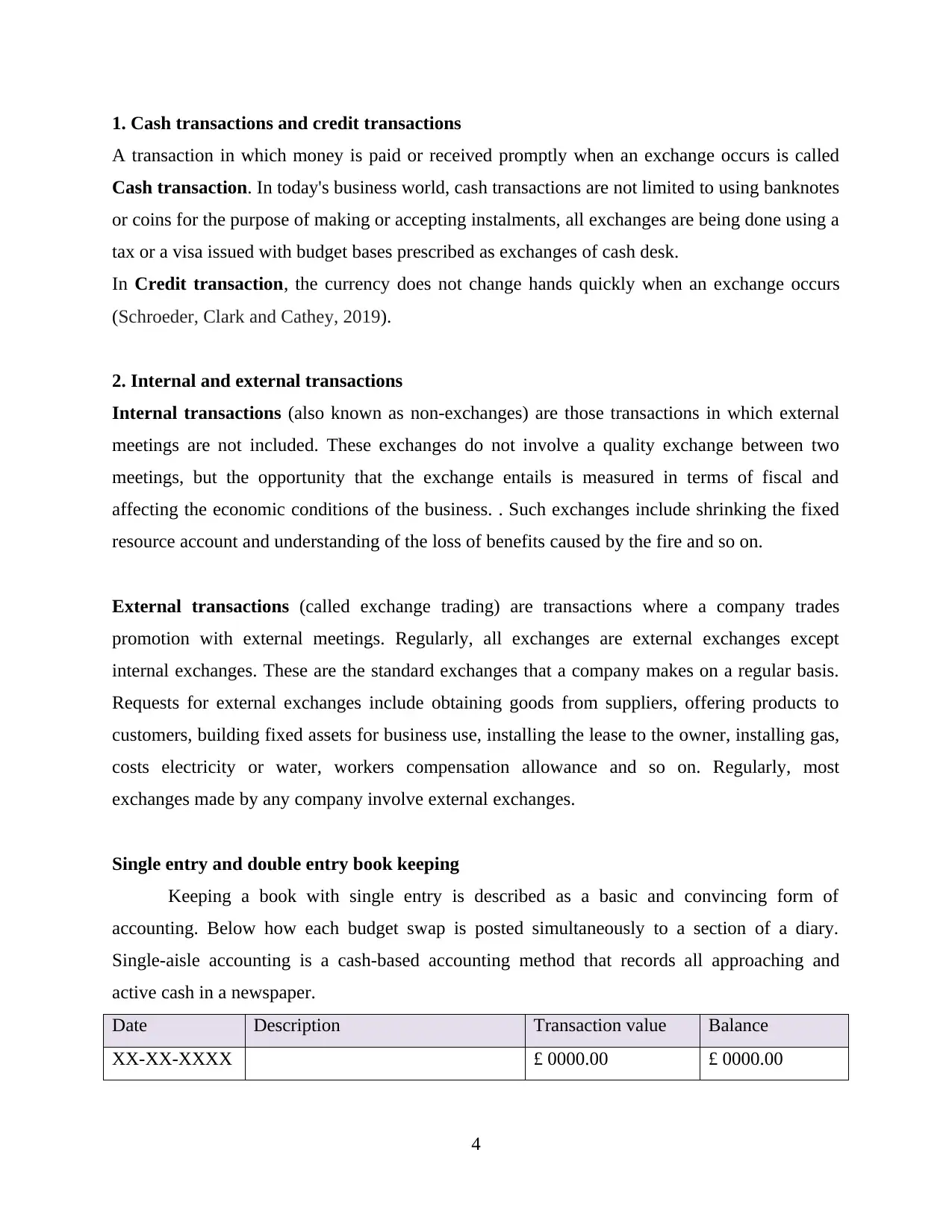
1. Cash transactions and credit transactions
A transaction in which money is paid or received promptly when an exchange occurs is called
Cash transaction. In today's business world, cash transactions are not limited to using banknotes
or coins for the purpose of making or accepting instalments, all exchanges are being done using a
tax or a visa issued with budget bases prescribed as exchanges of cash desk.
In Credit transaction, the currency does not change hands quickly when an exchange occurs
(Schroeder, Clark and Cathey, 2019).
2. Internal and external transactions
Internal transactions (also known as non-exchanges) are those transactions in which external
meetings are not included. These exchanges do not involve a quality exchange between two
meetings, but the opportunity that the exchange entails is measured in terms of fiscal and
affecting the economic conditions of the business. . Such exchanges include shrinking the fixed
resource account and understanding of the loss of benefits caused by the fire and so on.
External transactions (called exchange trading) are transactions where a company trades
promotion with external meetings. Regularly, all exchanges are external exchanges except
internal exchanges. These are the standard exchanges that a company makes on a regular basis.
Requests for external exchanges include obtaining goods from suppliers, offering products to
customers, building fixed assets for business use, installing the lease to the owner, installing gas,
costs electricity or water, workers compensation allowance and so on. Regularly, most
exchanges made by any company involve external exchanges.
Single entry and double entry book keeping
Keeping a book with single entry is described as a basic and convincing form of
accounting. Below how each budget swap is posted simultaneously to a section of a diary.
Single-aisle accounting is a cash-based accounting method that records all approaching and
active cash in a newspaper.
Date Description Transaction value Balance
XX-XX-XXXX £ 0000.00 £ 0000.00
4
A transaction in which money is paid or received promptly when an exchange occurs is called
Cash transaction. In today's business world, cash transactions are not limited to using banknotes
or coins for the purpose of making or accepting instalments, all exchanges are being done using a
tax or a visa issued with budget bases prescribed as exchanges of cash desk.
In Credit transaction, the currency does not change hands quickly when an exchange occurs
(Schroeder, Clark and Cathey, 2019).
2. Internal and external transactions
Internal transactions (also known as non-exchanges) are those transactions in which external
meetings are not included. These exchanges do not involve a quality exchange between two
meetings, but the opportunity that the exchange entails is measured in terms of fiscal and
affecting the economic conditions of the business. . Such exchanges include shrinking the fixed
resource account and understanding of the loss of benefits caused by the fire and so on.
External transactions (called exchange trading) are transactions where a company trades
promotion with external meetings. Regularly, all exchanges are external exchanges except
internal exchanges. These are the standard exchanges that a company makes on a regular basis.
Requests for external exchanges include obtaining goods from suppliers, offering products to
customers, building fixed assets for business use, installing the lease to the owner, installing gas,
costs electricity or water, workers compensation allowance and so on. Regularly, most
exchanges made by any company involve external exchanges.
Single entry and double entry book keeping
Keeping a book with single entry is described as a basic and convincing form of
accounting. Below how each budget swap is posted simultaneously to a section of a diary.
Single-aisle accounting is a cash-based accounting method that records all approaching and
active cash in a newspaper.
Date Description Transaction value Balance
XX-XX-XXXX £ 0000.00 £ 0000.00
4
Paraphrase This Document
Need a fresh take? Get an instant paraphrase of this document with our AI Paraphraser
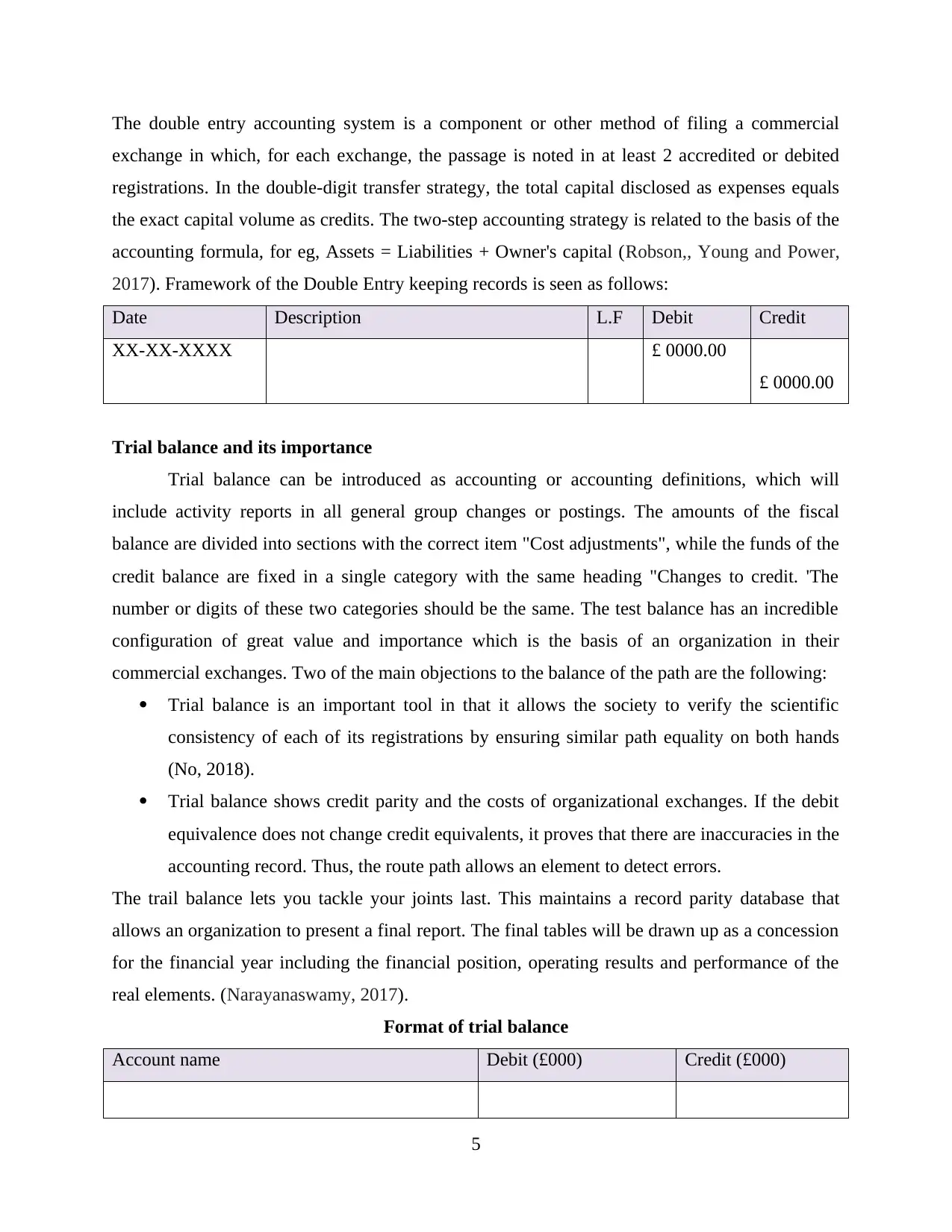
The double entry accounting system is a component or other method of filing a commercial
exchange in which, for each exchange, the passage is noted in at least 2 accredited or debited
registrations. In the double-digit transfer strategy, the total capital disclosed as expenses equals
the exact capital volume as credits. The two-step accounting strategy is related to the basis of the
accounting formula, for eg, Assets = Liabilities + Owner's capital (Robson,, Young and Power,
2017). Framework of the Double Entry keeping records is seen as follows:
Date Description L.F Debit Credit
XX-XX-XXXX £ 0000.00
£ 0000.00
Trial balance and its importance
Trial balance can be introduced as accounting or accounting definitions, which will
include activity reports in all general group changes or postings. The amounts of the fiscal
balance are divided into sections with the correct item "Cost adjustments", while the funds of the
credit balance are fixed in a single category with the same heading "Changes to credit. 'The
number or digits of these two categories should be the same. The test balance has an incredible
configuration of great value and importance which is the basis of an organization in their
commercial exchanges. Two of the main objections to the balance of the path are the following:
Trial balance is an important tool in that it allows the society to verify the scientific
consistency of each of its registrations by ensuring similar path equality on both hands
(No, 2018).
Trial balance shows credit parity and the costs of organizational exchanges. If the debit
equivalence does not change credit equivalents, it proves that there are inaccuracies in the
accounting record. Thus, the route path allows an element to detect errors.
The trail balance lets you tackle your joints last. This maintains a record parity database that
allows an organization to present a final report. The final tables will be drawn up as a concession
for the financial year including the financial position, operating results and performance of the
real elements. (Narayanaswamy, 2017).
Format of trial balance
Account name Debit (£000) Credit (£000)
5
exchange in which, for each exchange, the passage is noted in at least 2 accredited or debited
registrations. In the double-digit transfer strategy, the total capital disclosed as expenses equals
the exact capital volume as credits. The two-step accounting strategy is related to the basis of the
accounting formula, for eg, Assets = Liabilities + Owner's capital (Robson,, Young and Power,
2017). Framework of the Double Entry keeping records is seen as follows:
Date Description L.F Debit Credit
XX-XX-XXXX £ 0000.00
£ 0000.00
Trial balance and its importance
Trial balance can be introduced as accounting or accounting definitions, which will
include activity reports in all general group changes or postings. The amounts of the fiscal
balance are divided into sections with the correct item "Cost adjustments", while the funds of the
credit balance are fixed in a single category with the same heading "Changes to credit. 'The
number or digits of these two categories should be the same. The test balance has an incredible
configuration of great value and importance which is the basis of an organization in their
commercial exchanges. Two of the main objections to the balance of the path are the following:
Trial balance is an important tool in that it allows the society to verify the scientific
consistency of each of its registrations by ensuring similar path equality on both hands
(No, 2018).
Trial balance shows credit parity and the costs of organizational exchanges. If the debit
equivalence does not change credit equivalents, it proves that there are inaccuracies in the
accounting record. Thus, the route path allows an element to detect errors.
The trail balance lets you tackle your joints last. This maintains a record parity database that
allows an organization to present a final report. The final tables will be drawn up as a concession
for the financial year including the financial position, operating results and performance of the
real elements. (Narayanaswamy, 2017).
Format of trial balance
Account name Debit (£000) Credit (£000)
5
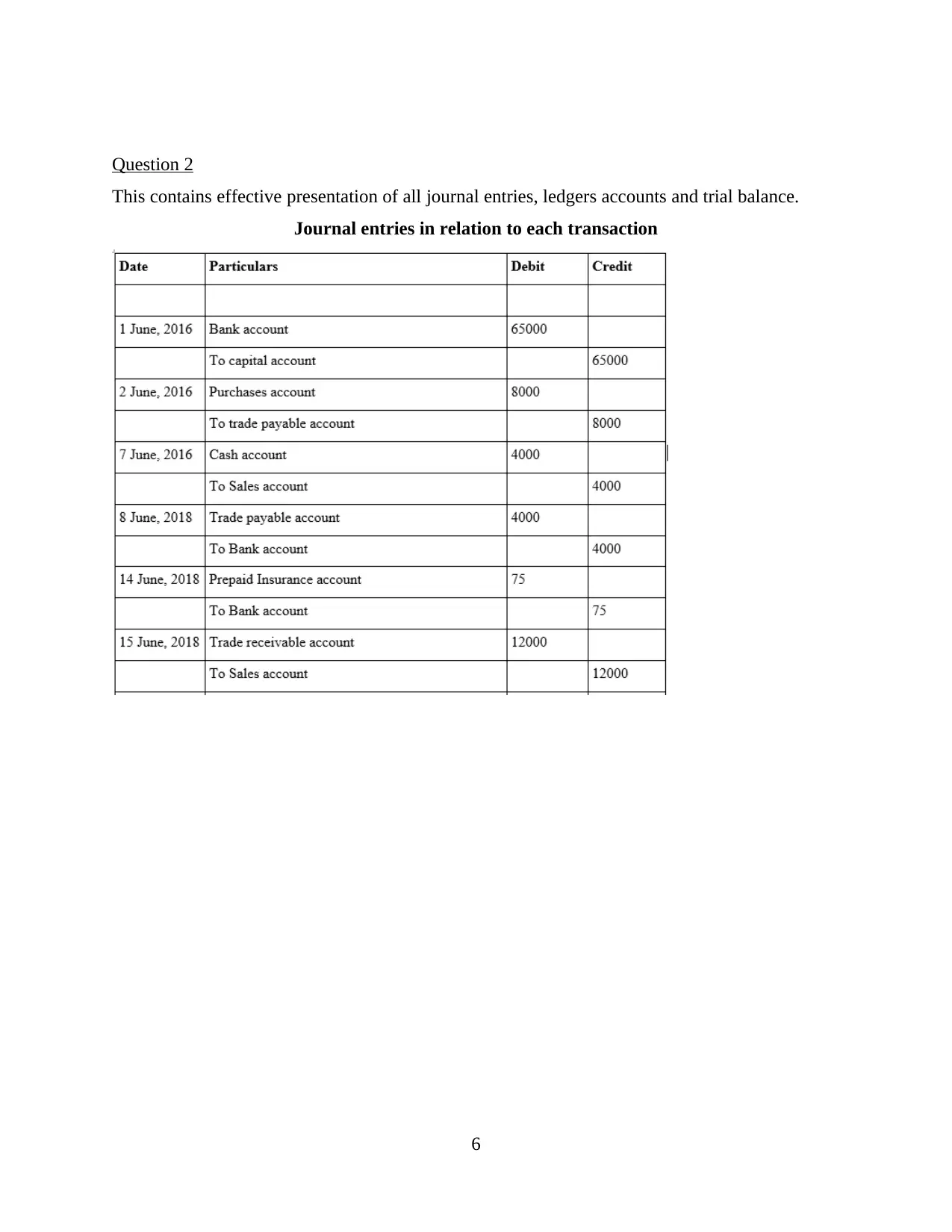
Question 2
This contains effective presentation of all journal entries, ledgers accounts and trial balance.
Journal entries in relation to each transaction
6
This contains effective presentation of all journal entries, ledgers accounts and trial balance.
Journal entries in relation to each transaction
6
⊘ This is a preview!⊘
Do you want full access?
Subscribe today to unlock all pages.

Trusted by 1+ million students worldwide
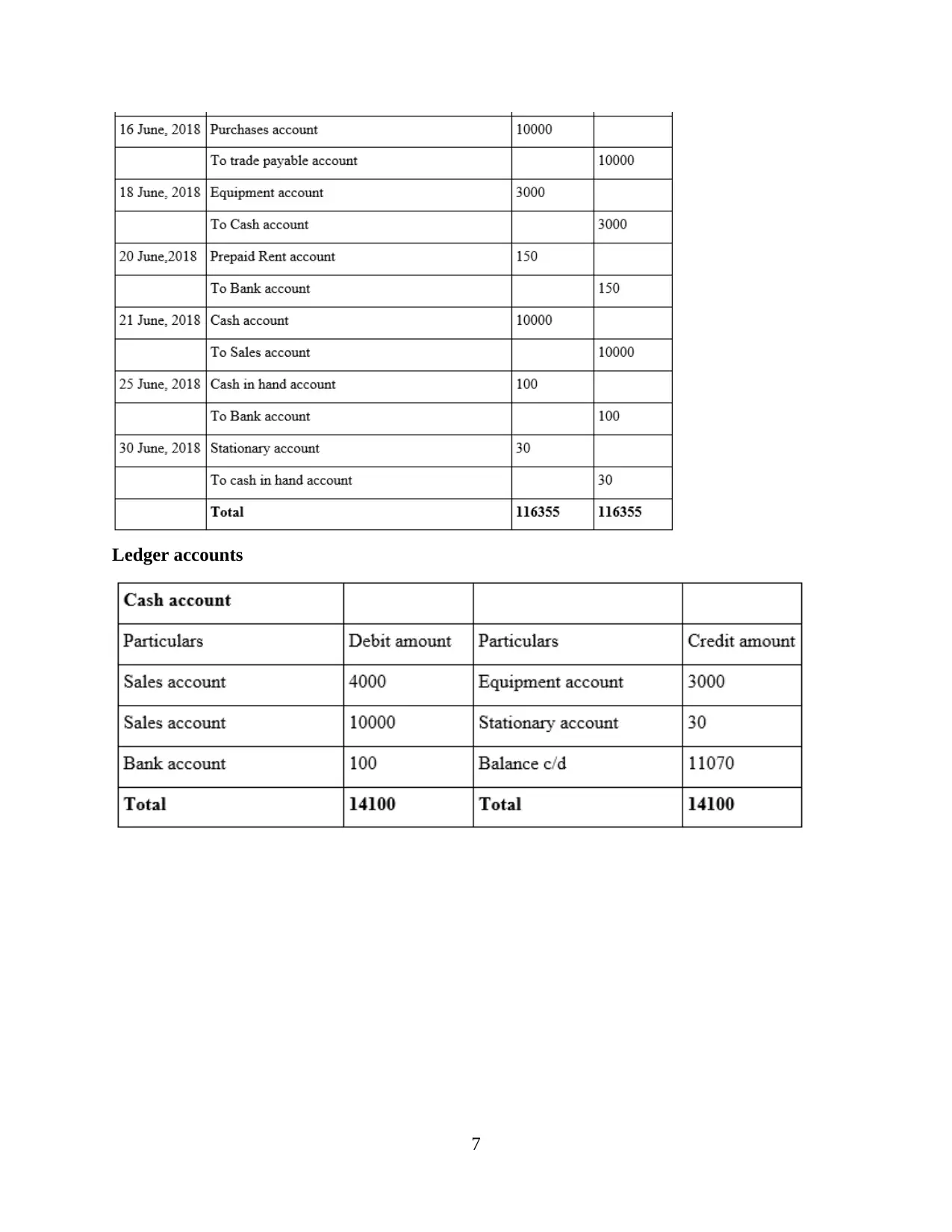
Ledger accounts
7
7
Paraphrase This Document
Need a fresh take? Get an instant paraphrase of this document with our AI Paraphraser
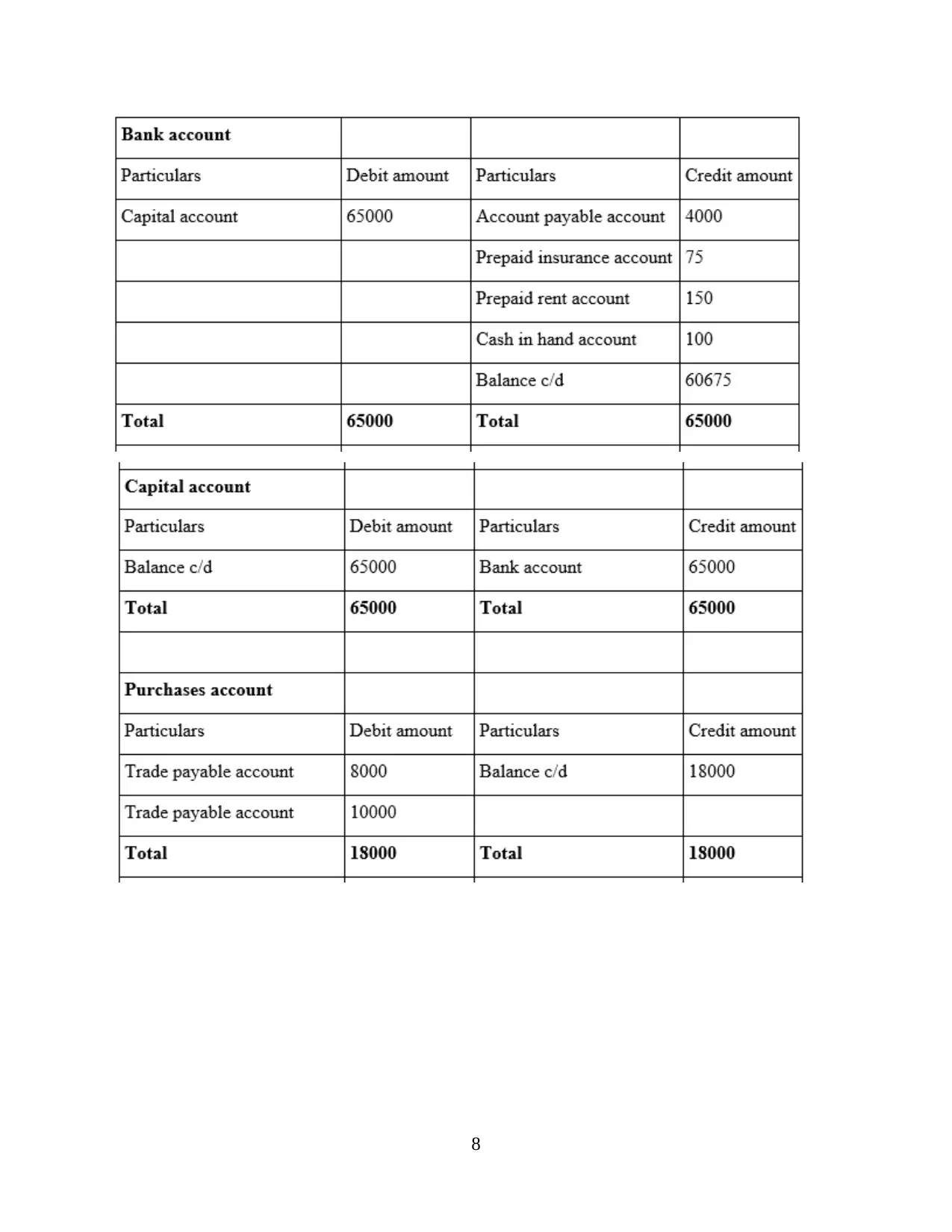
8
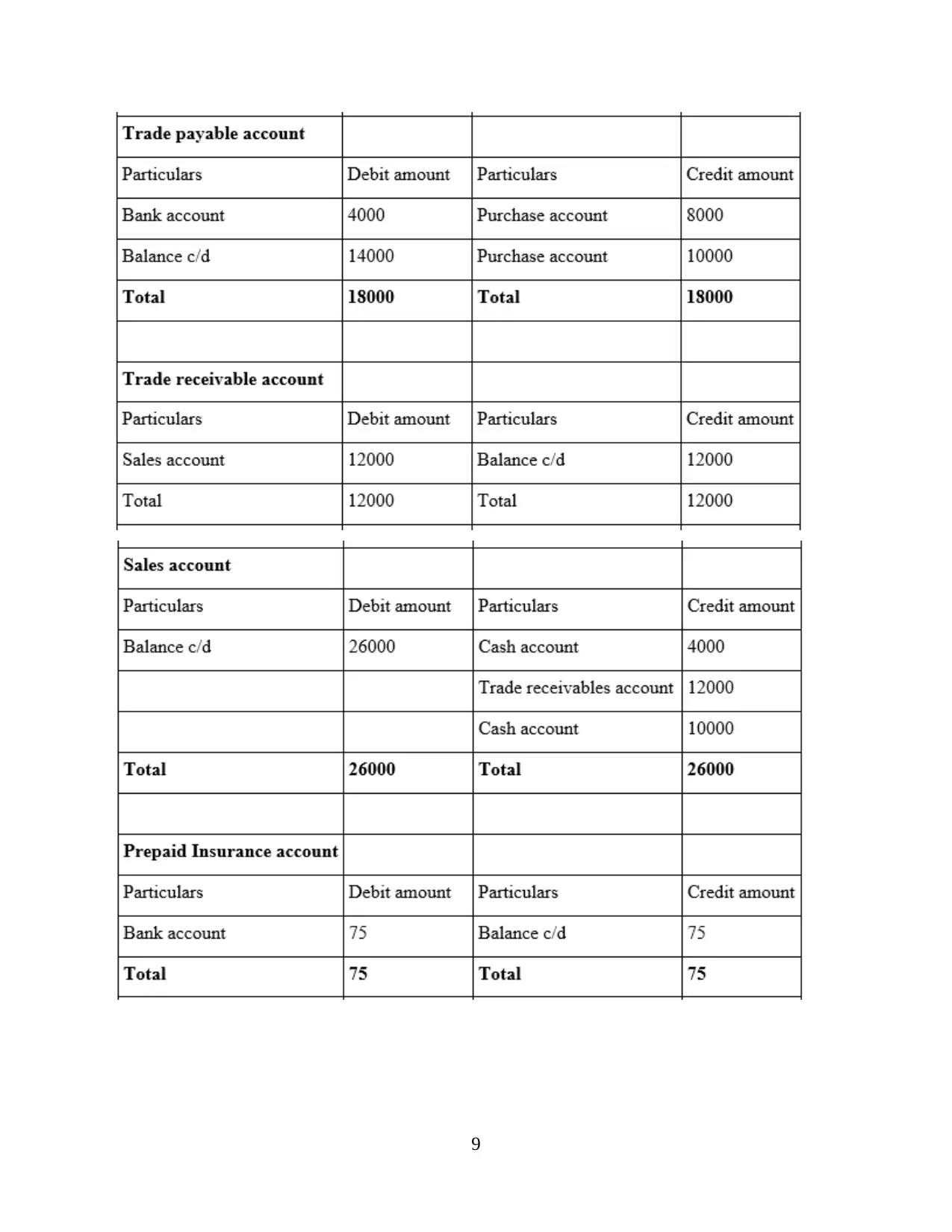
9
⊘ This is a preview!⊘
Do you want full access?
Subscribe today to unlock all pages.

Trusted by 1+ million students worldwide
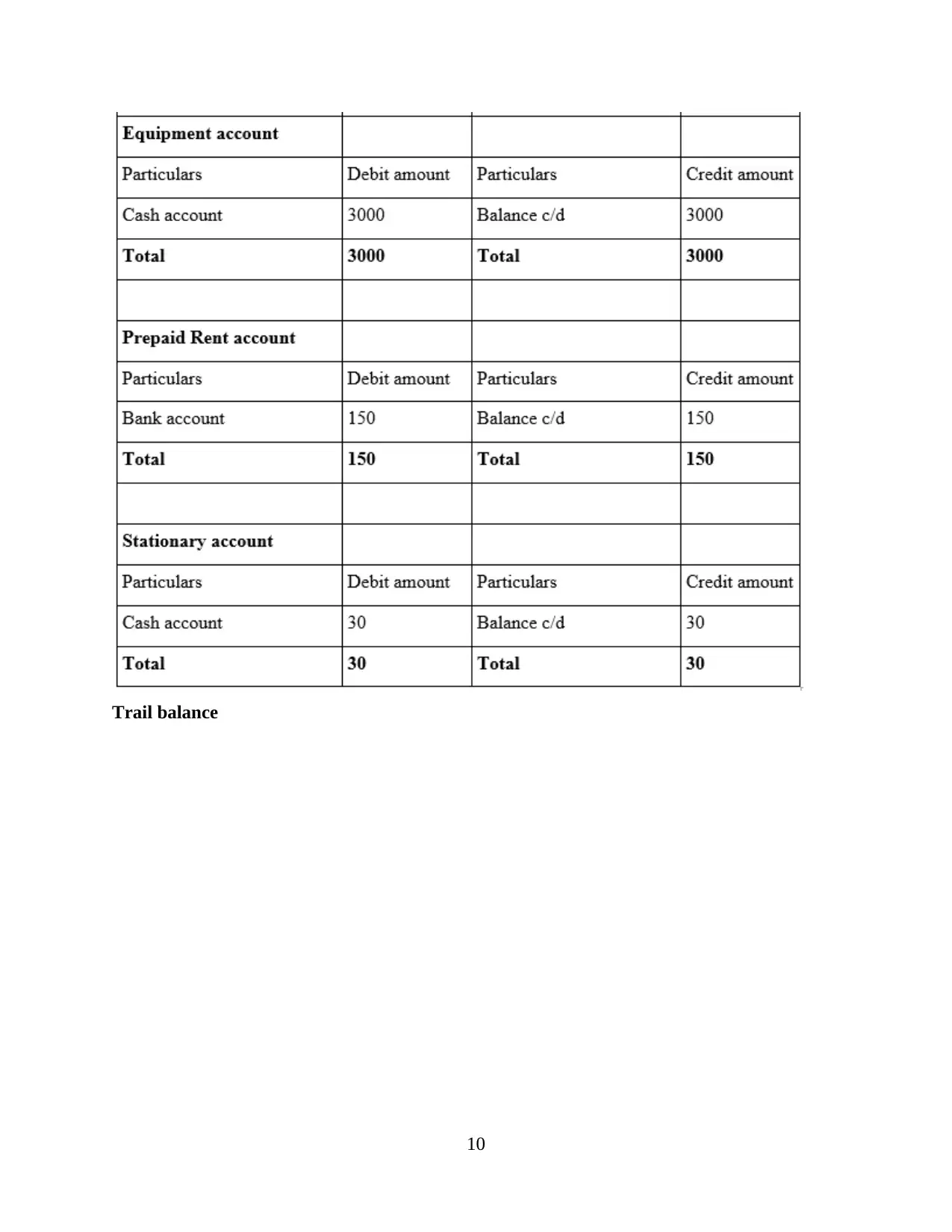
Trail balance
10
10
Paraphrase This Document
Need a fresh take? Get an instant paraphrase of this document with our AI Paraphraser
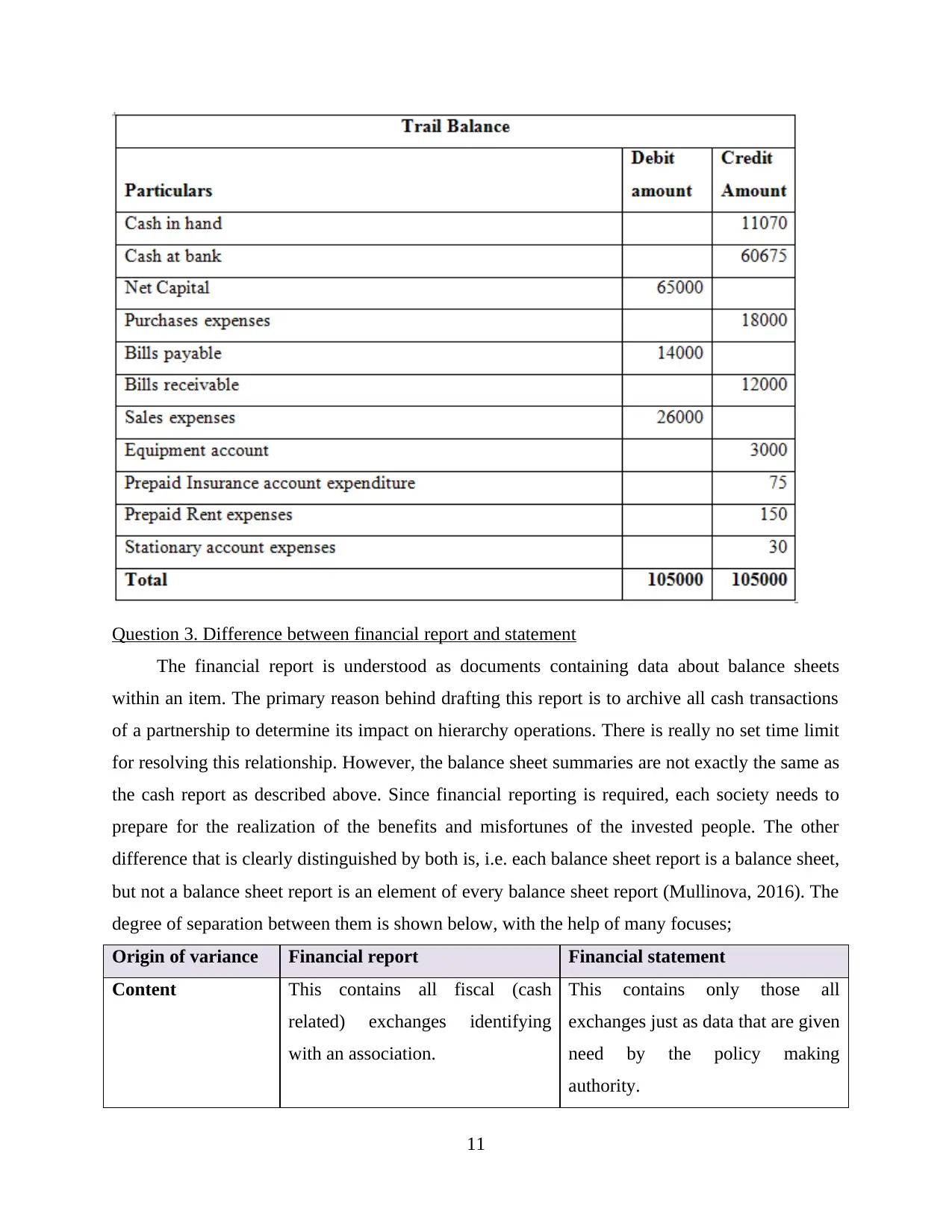
Question 3. Difference between financial report and statement
The financial report is understood as documents containing data about balance sheets
within an item. The primary reason behind drafting this report is to archive all cash transactions
of a partnership to determine its impact on hierarchy operations. There is really no set time limit
for resolving this relationship. However, the balance sheet summaries are not exactly the same as
the cash report as described above. Since financial reporting is required, each society needs to
prepare for the realization of the benefits and misfortunes of the invested people. The other
difference that is clearly distinguished by both is, i.e. each balance sheet report is a balance sheet,
but not a balance sheet report is an element of every balance sheet report (Mullinova, 2016). The
degree of separation between them is shown below, with the help of many focuses;
Origin of variance Financial report Financial statement
Content This contains all fiscal (cash
related) exchanges identifying
with an association.
This contains only those all
exchanges just as data that are given
need by the policy making
authority.
11
The financial report is understood as documents containing data about balance sheets
within an item. The primary reason behind drafting this report is to archive all cash transactions
of a partnership to determine its impact on hierarchy operations. There is really no set time limit
for resolving this relationship. However, the balance sheet summaries are not exactly the same as
the cash report as described above. Since financial reporting is required, each society needs to
prepare for the realization of the benefits and misfortunes of the invested people. The other
difference that is clearly distinguished by both is, i.e. each balance sheet report is a balance sheet,
but not a balance sheet report is an element of every balance sheet report (Mullinova, 2016). The
degree of separation between them is shown below, with the help of many focuses;
Origin of variance Financial report Financial statement
Content This contains all fiscal (cash
related) exchanges identifying
with an association.
This contains only those all
exchanges just as data that are given
need by the policy making
authority.
11
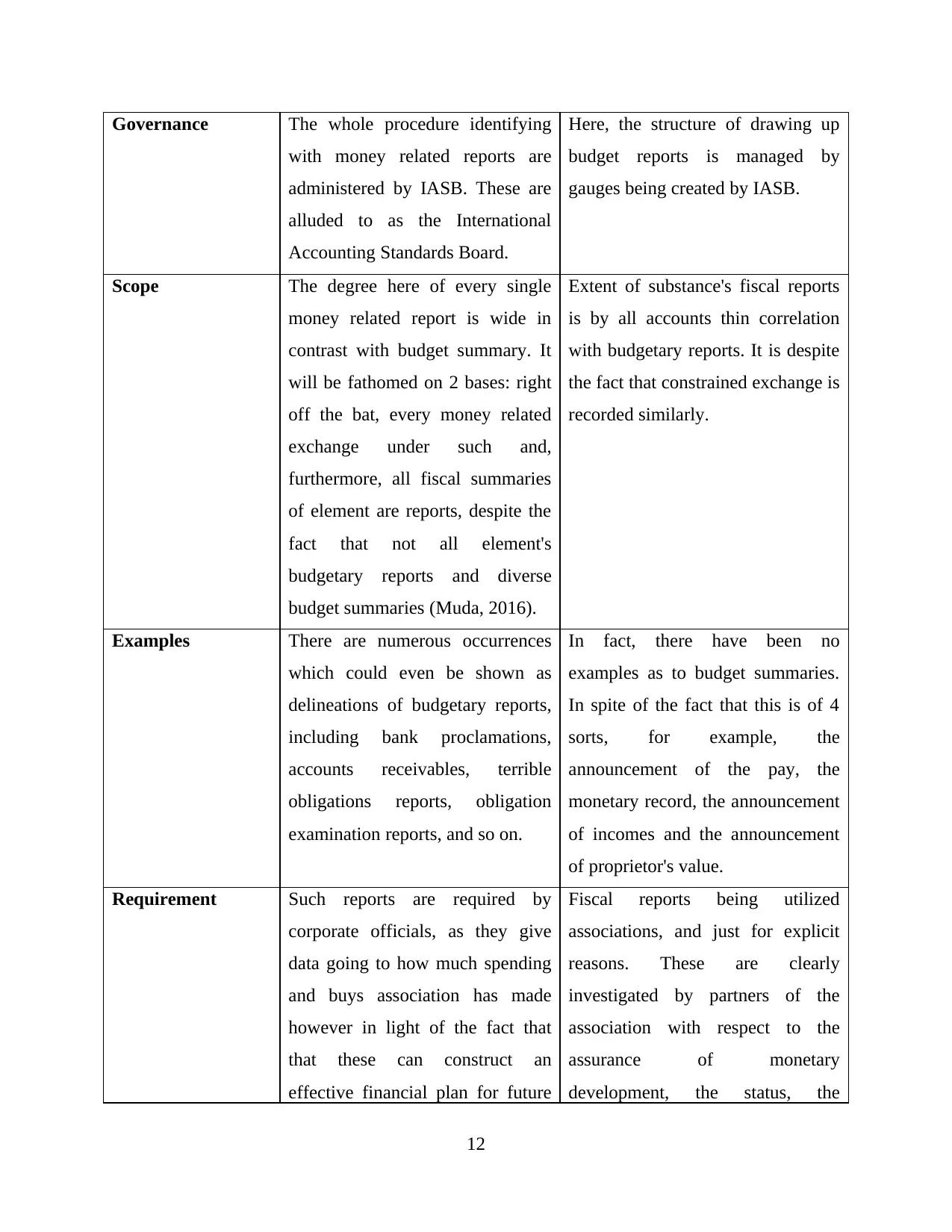
Governance The whole procedure identifying
with money related reports are
administered by IASB. These are
alluded to as the International
Accounting Standards Board.
Here, the structure of drawing up
budget reports is managed by
gauges being created by IASB.
Scope The degree here of every single
money related report is wide in
contrast with budget summary. It
will be fathomed on 2 bases: right
off the bat, every money related
exchange under such and,
furthermore, all fiscal summaries
of element are reports, despite the
fact that not all element's
budgetary reports and diverse
budget summaries (Muda, 2016).
Extent of substance's fiscal reports
is by all accounts thin correlation
with budgetary reports. It is despite
the fact that constrained exchange is
recorded similarly.
Examples There are numerous occurrences
which could even be shown as
delineations of budgetary reports,
including bank proclamations,
accounts receivables, terrible
obligations reports, obligation
examination reports, and so on.
In fact, there have been no
examples as to budget summaries.
In spite of the fact that this is of 4
sorts, for example, the
announcement of the pay, the
monetary record, the announcement
of incomes and the announcement
of proprietor's value.
Requirement Such reports are required by
corporate officials, as they give
data going to how much spending
and buys association has made
however in light of the fact that
that these can construct an
effective financial plan for future
Fiscal reports being utilized
associations, and just for explicit
reasons. These are clearly
investigated by partners of the
association with respect to the
assurance of monetary
development, the status, the
12
with money related reports are
administered by IASB. These are
alluded to as the International
Accounting Standards Board.
Here, the structure of drawing up
budget reports is managed by
gauges being created by IASB.
Scope The degree here of every single
money related report is wide in
contrast with budget summary. It
will be fathomed on 2 bases: right
off the bat, every money related
exchange under such and,
furthermore, all fiscal summaries
of element are reports, despite the
fact that not all element's
budgetary reports and diverse
budget summaries (Muda, 2016).
Extent of substance's fiscal reports
is by all accounts thin correlation
with budgetary reports. It is despite
the fact that constrained exchange is
recorded similarly.
Examples There are numerous occurrences
which could even be shown as
delineations of budgetary reports,
including bank proclamations,
accounts receivables, terrible
obligations reports, obligation
examination reports, and so on.
In fact, there have been no
examples as to budget summaries.
In spite of the fact that this is of 4
sorts, for example, the
announcement of the pay, the
monetary record, the announcement
of incomes and the announcement
of proprietor's value.
Requirement Such reports are required by
corporate officials, as they give
data going to how much spending
and buys association has made
however in light of the fact that
that these can construct an
effective financial plan for future
Fiscal reports being utilized
associations, and just for explicit
reasons. These are clearly
investigated by partners of the
association with respect to the
assurance of monetary
development, the status, the
12
⊘ This is a preview!⊘
Do you want full access?
Subscribe today to unlock all pages.

Trusted by 1+ million students worldwide
1 out of 22
Related Documents
Your All-in-One AI-Powered Toolkit for Academic Success.
+13062052269
info@desklib.com
Available 24*7 on WhatsApp / Email
![[object Object]](/_next/static/media/star-bottom.7253800d.svg)
Unlock your academic potential
Copyright © 2020–2025 A2Z Services. All Rights Reserved. Developed and managed by ZUCOL.





